12 May 2012, Kuala Lumpur – Let’s have a look at one of Susan Polgar’s past chess games. She wrote a book entitled Breaking Through which chronicles her rise in the Chess World.
| Game 3 |
| Susan Polgar (White) |
| Stefan Gross (Black) |
| Stary Smokovec 1987 |
| English Opening |
1 d4
This game was played at a grandmaster tournament in a small, but beautiful mountain city in mountain city in Czechoslovakia.
1….Nf6
My opponent is one of the local International Masters.
2 Nf3
This move prevents a few gambit variations, such as the Benko or the Budapest, and simplifies some of White’s opening preparations.
2…g6
After this, Black will still have a choice between the King’s Indian or the Grunfeld, depending where the black d-pawn moves.
3 g3
This is one of the more solid ways to fight the King’s Indian or Grunfeld.
3…Bg7
Black is getting ready to castle.
4 Bg2
Sometimes I prefer to play c2-c4 first. It is just a matter of taste.
4…0-0
Black’s last two moves were quite automatic.
5 0-0
Again 5 c4 is a logical and sound alternative.
5…c5
At this moment, Black has two other good options in 5…d6 or 5…d5.
6 c4
It would be too greedy to capture with 6 dxc5 and, after 6…Na6, try to hang on to the pawn with 7 Be3 Qc7 8 Qd4?, because of 8…Ne8 followed by …Bxb2.
6…cxd4
Another common move is to protect the pawn on c5 with 6…d6.
7 Nxd4
Tacking back with 7 Qxd4 would break the rule of not bringing your queen out early! After the natural 7…Nc6, White would lose time by having to move the queen again.
7…Nc6
A good developing move. A trade on c6 would only help Black.
8.Nc3
Now if Black moves either the b- or d-pawns, White would take the knight on c6 with 9 Nxc6. 8 b3 would be a blunder since it would open the a1-h8 diagonal prematurely, allowing Black to win material by 8…Nxd4 9 Qxd4 Ne8.
8 …Nxd4
Otherwise Black has difficulties getting the bishop on c8 out.
9 Qxd4
Now the white queen has been forced to advance, but the difference is that Black cannot chase it away with …Nb8-c6,
9…d6
Opening the diagonal for the bishop on c8. None of the knight moves would result in any gain for Black.
10 Qd3
At first it seems that 10 b3 would be a big mistake, because 10…Ne4 11 Qxe4 Bxc3 12 Rb1 Bf5 wins the rook on b1. But after a deeper look we can find 13 Qf3 Bxb1 14 Qxc3 Bf5 15 Bh6, when White gains the sacrificed material back with a favorable position, 12 Bg5 is also a good option, so 10 b3 is quite playable. Nevertheless, Susan prefers the continuation of the actual game, removing the queen from a potential discovered attack.
10 …Nd7
With the idea of relocating the knight to either e5 or c5. Having the knight on c5 will attack the white queen and protect the b7 pawn at the same time, helping the development of the bishop on c8.
Other common and logical moves are 10…a6 or 10…Rb8 to prepare the …b7-b5 advance.
11 b3
Now it is completely safe to play 11 b3. This move accomplishes two goals at once. It prepares the development of White’s bishop to b2, and also protects the c4 pawn to free up the white queen. Therefore, if Black plays …Nd7-e5, the queen will be free to move away without the necessity of guarding the pawn.
11…Nc5
After White’s last move, the c4 pawn now being safe, this move is now a lot more logical than …Nd7-e5.
12 Qd2
It may seem illogical and unnatural to put the queen in front of the bishop, but it is only a very temporary problem as White’s next move will be 13 Bb2.
12…Rb8
The rook gets out of the pin along the h1-a8 diagonal, to prepare counterplay with …b7-b5.
13 Bb2
The only logical move! 13 b4 would be premature, allowing Black to use the pin effectively by playing 13..Na4.
13….a6
There is a famous trick that Black could have fallen into if he was not careful: 13…Qa5 14 Rad1 and now 14…Rd8? would be a big mistake, because White wins a pawn by 15 Nd5! Qxd2 and now the intermediate check of 16 Nxe7+ Kf8 17 Bxg7+ Kxg7 18 Rxd2.
14 Nd5
It is usually a good idea to centralize the knight when you can. Here the important point is that if Black chases the knight away with …e7-e6, the d6 pawn would become a long term weakness.
14…Bxb2
Black could only worsen his position by avoiding the trade of bishops.
15 Qxb2
Now the queen takes control of the long (a1-h8) diagonal. It puts in the back of Susan’s mind some checkmate potential, either by pushing the h-pawn up to h4-h5-h6 (followed by Qg7 mate), or maybe somehow luring the black queen away from protecting the e7 pawn and then mate with Nxe7.
15…b5
This is the only opportunity Black has for counterplay.
16 cxb5
16 b4 would let the advantage slip out of White’s hands. The knight would not need to move as Black can play 16…bxc4 creating a pin on the b4 pawn.
16…axb5
Taking back with the rook is also playable, although Susan does not think it is a considerable improvement on Black’s position.
17 Rfd1
This is one of those ‘it just fits the position’ kind of moves, putting the rook on the half open file.
17…Bb7
Black’s best bet is to try to trade the bishop for White’s powerful knight. Chasing away the knight with 17…e6 would now be outright suicidal, as White wins with 18 Nf6+ Kh8 (things end even more quickly after 18…Kg7, when it is White to move and mate in five! 19 Nh5+ Kh6 20 Qg7+ Kxh5 21 Qxh7+ Kg5 22 Qh4+ Kf5 23 Qf4 mate) 19 Rxd6! Qxd6 20 Nxe8+ and by this discovered check, Black loses the queen.
It is time to decide what plan to choose next. Here are Susan’s choices:
a) Trying to create a passed pawn on the a-file by preparing a2-a4.
b) Trying to attack the isolated b5 pawn.
c) Advancing the h2 pawn to h6 to create additional threats, due to the weakened dark squares near the black king.
18 h4
Susan chose to start with plan ‘C’ while maintaining the option to implement plan ‘a’ or ‘b’ later as well.
18…Bxd5
Black has solved one problem in getting rid of the knight. However, due to the exchange, White’s bishop has now gained more power.
19 Rxd5
Susan chose to recapture with the rook because Susan felt that , in some variations after h4-h5, it may come handy along the fifth rank in the kingside attack.
19…Nd7
This is a bit too passive. 19…b4 20 h5 e6 was a better defense, although after 21 h6 f6 22 Rd4 White still has favourable chances.
20 h5
Moving along as planned.
20…Nf6
At first it seems that Black has just made a fork by attacking White’s rook on d5 and pawn on h5, but White has a defense in mind.
21 h6
White can save both! With this move, White indirectly protects the rook.
21…Rb6
Of course the rook could not be taken, as checkmate would follow with 22 Qg7 mate.
22 Rad1
A preventive move.
22 …Qc7
If Black had played 22…e6, Susan planned a cute combination with 23 Rxd6! Rxd6 24 Rxd6 Qxd6 25 Qxf6 and checkmate is unavoidable without major material loss.
23 Rc1
Taking control of the open file with tempo.
23…Rc6
Moving the queen away with 23…Qd7 was a more solid defense.
24 Rxc6
Definitely the best choice, forcing the black queen into a discovered attack.
24 …Qxc6
Even though the white rook can go almost anywhere and create a discovered attack; there is nothing that would win material immediately.
25 Rf5
A tricky move, which could be deadly as my opponent was short on time.
25… Qe8
The only move. On 25..Qb6 White can win by sacrificing the rook with 26 Rxf6! etc., or if 25…d5 26 Rxd5!
26 Rf4
Now the rook is finally under real attack, so it is time to put it on a safe square. Here the same sacrifice with 26 Rxf6 exf6 27 Qxf6 does not work because of the saving move 27…Qe5.
26…Qd8
Black had a reasonable alternative in 26…Qc8, as 27 Rxf6 exf6 28 Qxf6 fails to 28…Qc1+ picking up the h6 pawn.
27 a4
Time to create a passed pawn on the a-file!
27…e5
Black tries to stop any threat from the white queen down the long diagonal. Had Black gone hunting for the h6 pawn, then the passed a-pawn would have become too fast to defend, e.g. 27…bxa4 28 bxa4 Qa5 29 Rb4 Qg5 30 Rb7 e5 (or 20…Re8 31 Bc6 Rc8 32 Rb8) 31 a5 Qxh6 32 a6.
28 Rb4
Attacking the b5 pawn a second time.
28 …Qa5
A very resourceful and tricky move!
29 Qd2
White would get in big trouble by being greedy with 29 Rxb5? Qe1+ 30 Bf1 (or 30 Kh2 Ng4+) 30…Ne4! 31 e3 Nd2.
29…bxa4
Here Black is in serious difficulties already, but the best hope for some ‘complications’ was probably 29…Ng4 30 Qxd6 Rd8.
30 bxa4
After the more aggressive 30 Qxd6, Black can steer into a rook endgame a pawn down with excellent drawing chances: 30…Ne8 31 Qe7 axb3 32 Rb8 Qc7! (but not 32…Qa4? 33 Bd5) 33 Rxe8 Qxe7 Rb8 35 Be4 b2 36 Bb1 Kf8 37 Rxe5 Rd8 38 Kg2 Rd1 39 Bc2 b1=Q 40 Bxb1 Rxb1.
30…d5
If Black protects the pawn on d6 with 30…Rd8, White can continue with 31 Qg5 Ne8 32 Rb7 creating a killer attack.
31 Qg5
Getting out of the pin by tactical means!
31…Ne8
Black could not accept the gift with 31…Qxb4, as after 32 Qxf6 mate on g7 would follow.
32 Qe7
32 Rb8 is also good.
32…e4
The game would have lasted somewhat longer after 32…Qc7 33 Rb7 Qxe7 34 Rxe7 e4 35 a5. Nevertheless, the result would be the same.
33 Rb8
Attacking the knight a second time.
33…Qxa4
Black protected the knight and took a pawn.
34 Qe5
Now the problem comes on g7 again!
34…f6
Otherwise 35 Rxe8 removes the guard of the g7 square and Qg7 mate follows.
35 Qe6+
To chase the king away from the rook on f8.
35…Kh8
Black has no alternative.
36 Qe7 Black resigned.
Attacking the rook on f8, while after 36…Kg8 37 Rxe8 Black gets mated on g7.












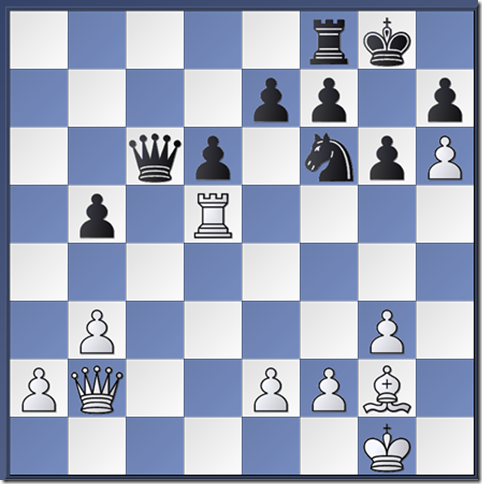

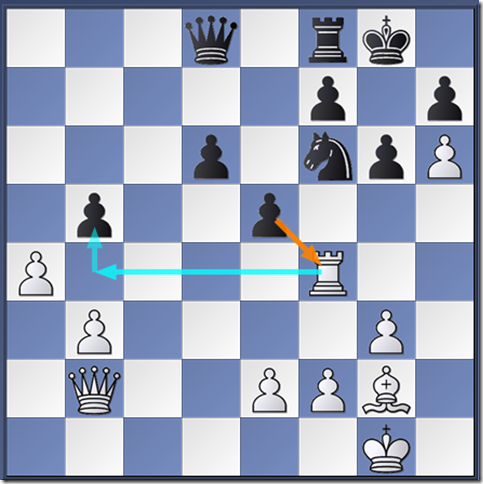
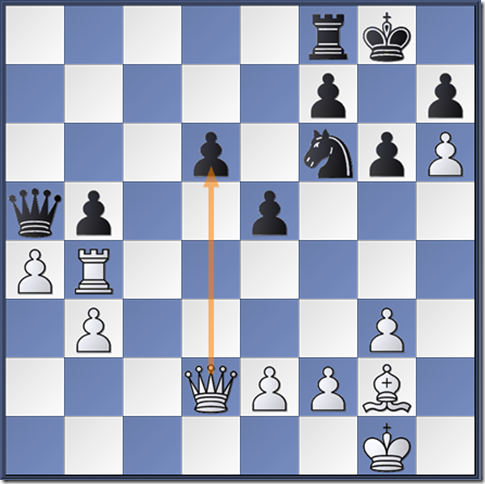
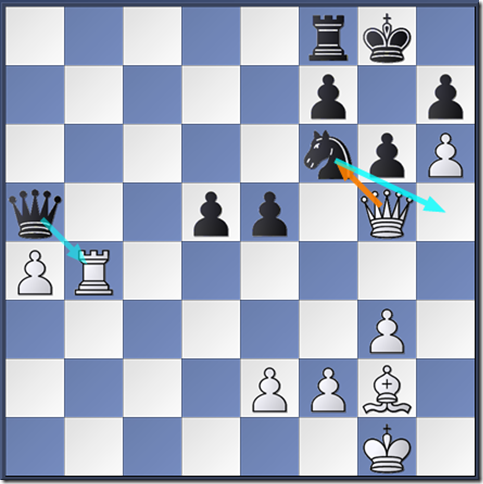
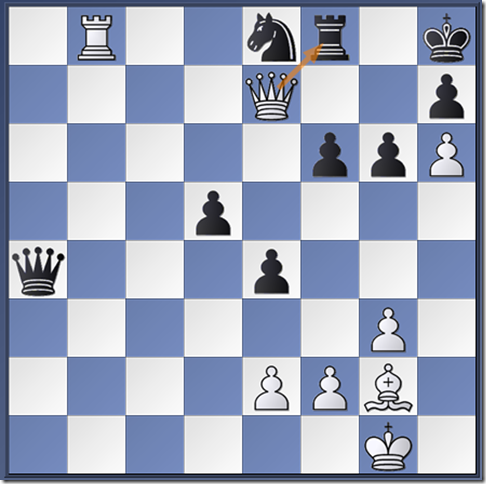

.JPG)





















No comments:
Post a Comment